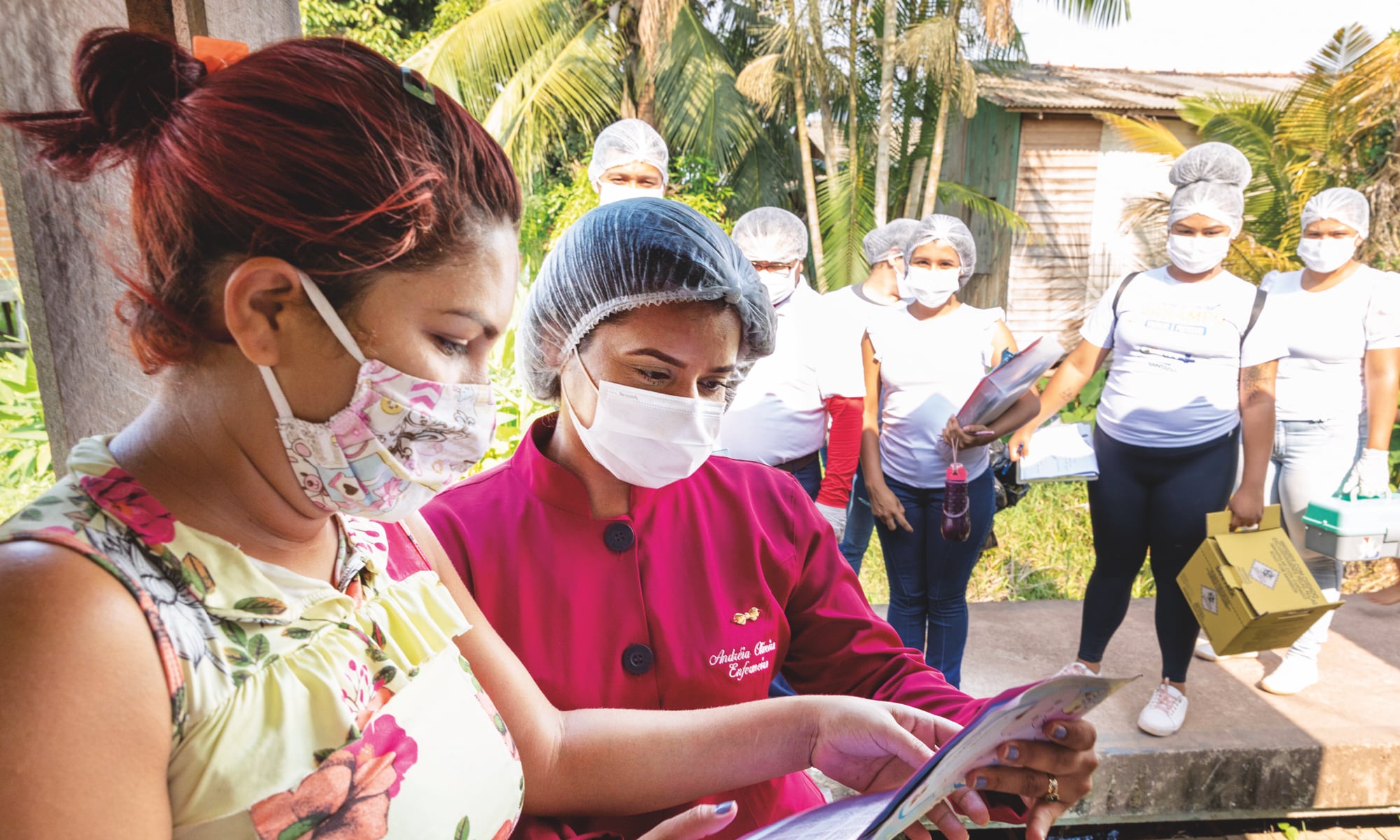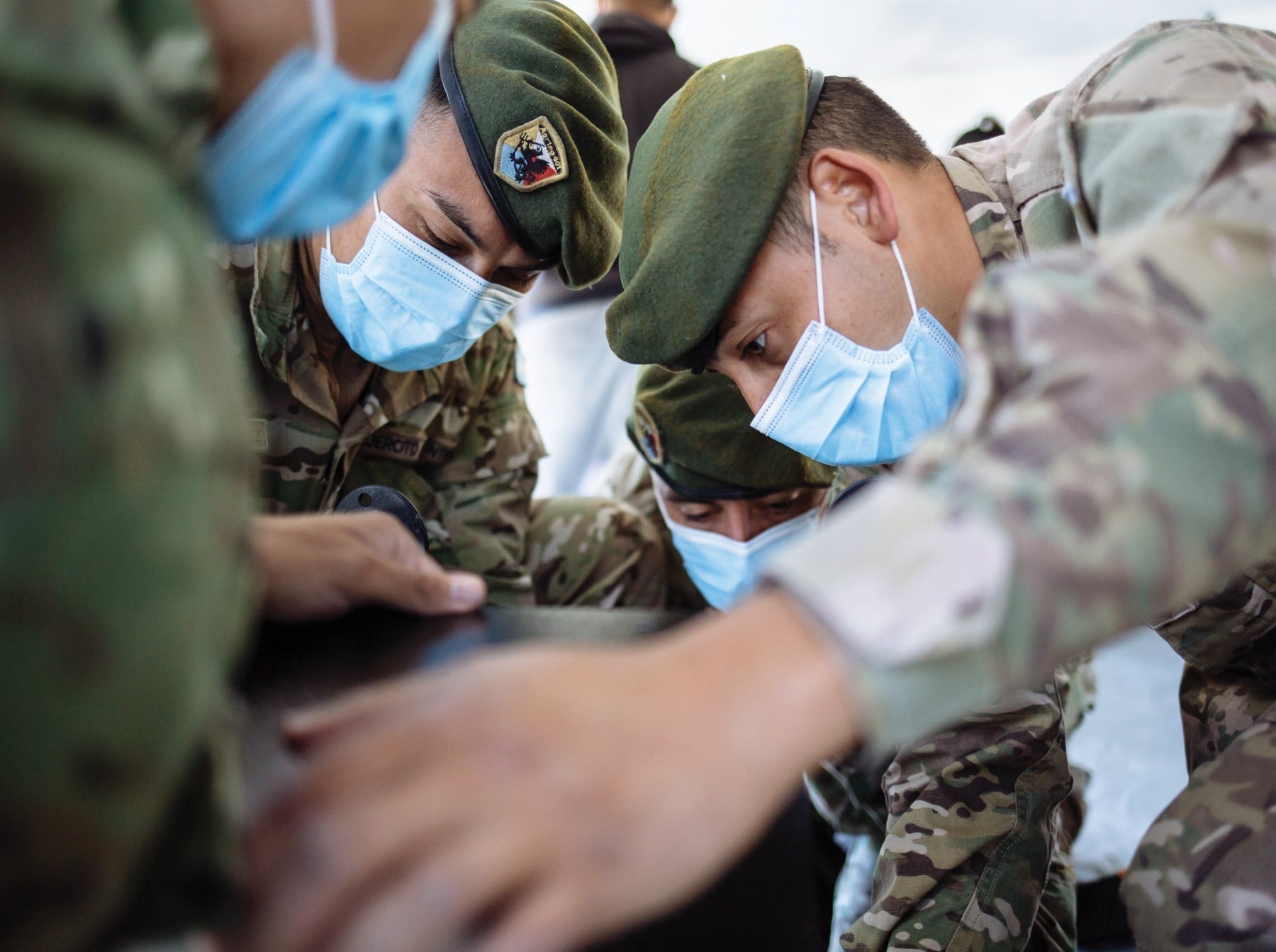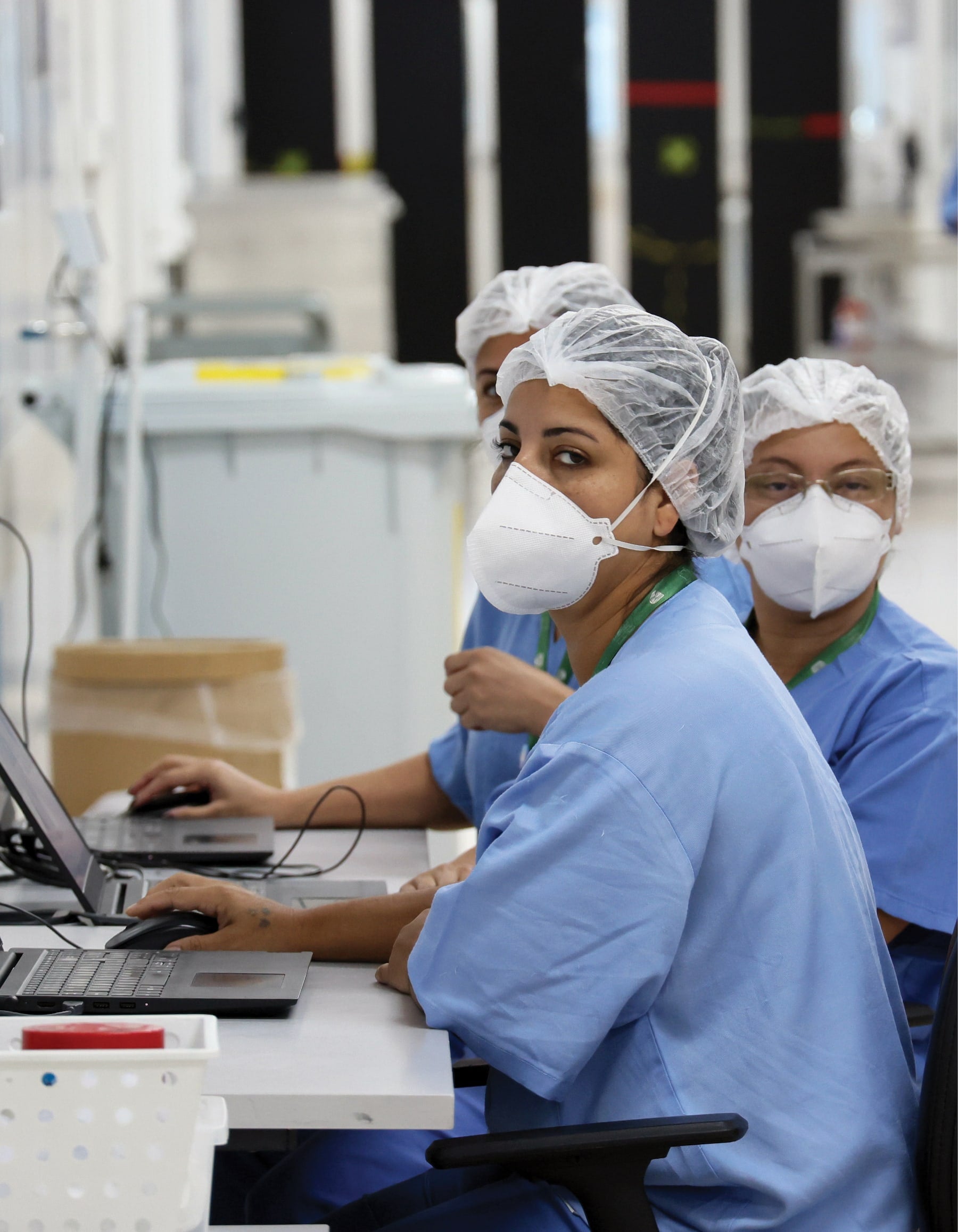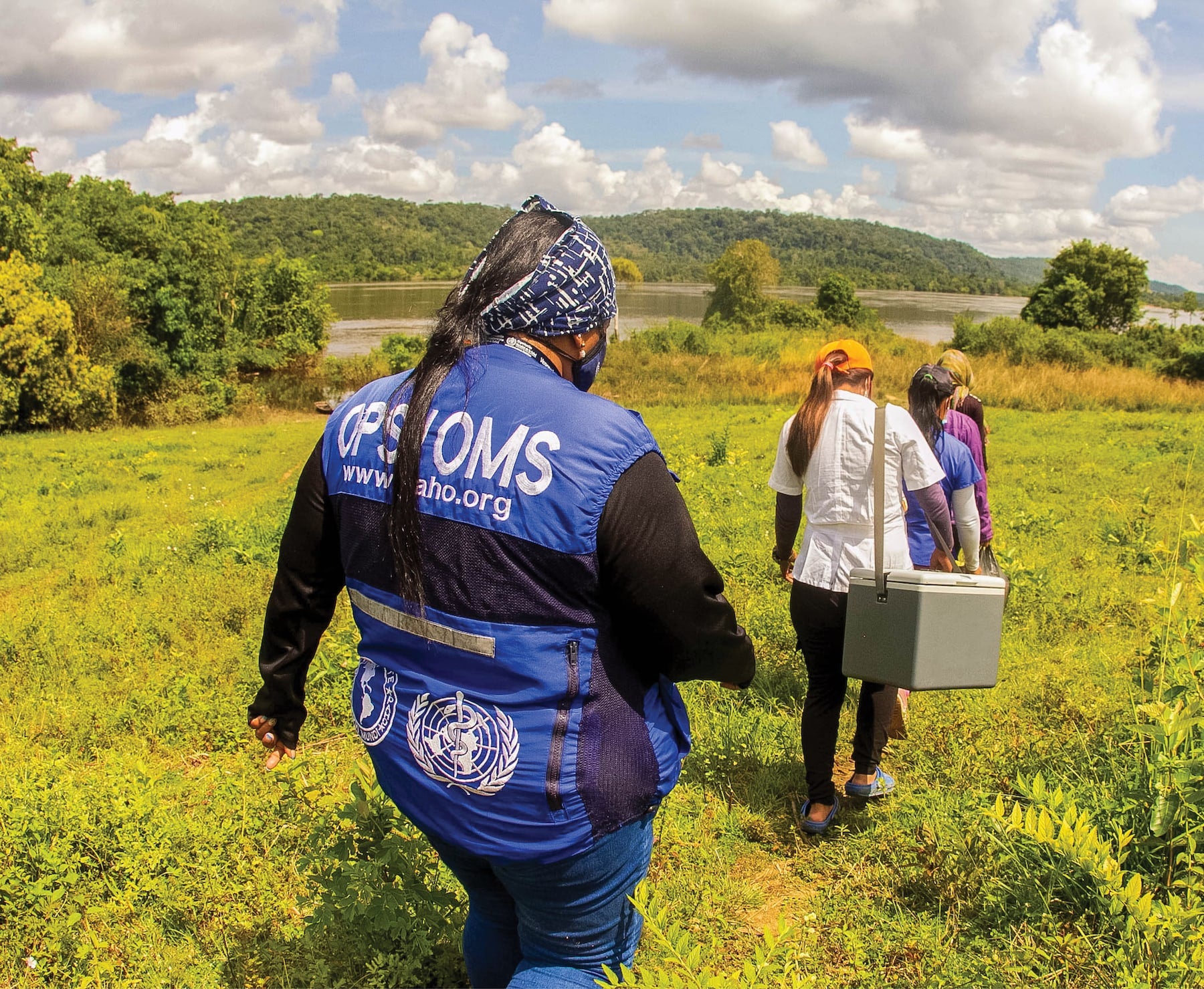As vaccination rates slowed across the Region, PAHO’s COVID‑19 response in 2022 shifted focus toward disparities in vaccine access – within and between countries – while strengthening core health service provision and acute care.
The persistence of the COVID‑19 pandemic into its third year meant that the transmission patterns of disease and its clinical features continued to evolve as new variants of the original virus became dominant. Careful tracking of these epidemiological patterns underpins PAHO’s activity-planning and priority-setting for the COVID‑19 response, within the framework of our long-standing integrated response plan.
Multiple distinct waves of infections were observed in numerous countries around the world during 2020 and 2021 and documented in the epidemiological literature. At the beginning of 2022, countries were already observing a new wave of infections caused by the highly transmissible Omicron variant, which continued to cause smaller surges as the year progressed. However, the lethality of COVID‑19 disease in the Region, as measured by the absolute number of deaths, dropped sharply: from 1.5 million in 2021 to just under 472 000 in 2022, a reduction of 68%. There was a corresponding decrease in the proportion of serious disease among diagnosed cases. These effects have been attributed to a combination of factors: the milder nature of the Omicron variant infection, improved clinical management of COVID‑19 disease, and increasingly high seroprevalence rates among the general population, resulting from a combination of high vaccination coverage (now over 70% across the Region) and levels of natural immunity developed after infection.
Overall, 2022 was the year that we began to see COVID‑19’s damaging impacts become more evident in broad health outcomes and health system indicators. Life expectancy in the Region, for example, has fallen from 75.1 years in 2019 to 72.2 years in 2021. By the end of 2021, 93% of the countries in the Americas had reported disruptions in essential health services. These are the worrying and lasting setbacks that will reshape the public health agenda – and our ongoing response to the COVID‑19 pandemic – for years to come.
US Government Support through ARPA
In response to PAHO’s Regional COVID‑19 Response Strategy and Donor Appeal, the US Government, through the American Rescue Plan Act (ARPA), provided US$ 75 million to help countries in Latin America and the Caribbean continue to scale up their responses to the pandemic and its wide-ranging impacts. The funding agreement included the following four main objectives:
- Objective 1: Accelerate widespread and equitable access to and delivery of safe and effective COVID‑19 vaccinations
- Objective 2: Reduce morbidity and mortality from COVID‑19, mitigate transmission, strengthen health systems, including to prevent, detect, and respond to pandemic threats
- Objective 3: Address acute needs driven by COVID‑19, mitigate household shocks, and build resilience
- Objective 4: Bolster economies and other critical systems under stress due to COVID‑19 to prevent backsliding and enable recovery.
The activities and priorities selected to meet these objectives dovetail with our integrated response plan and are fully aligned with the 2020, 2021, and 2022 WHO Strategic Preparedness and Response Plan for COVID‑19 as well as with PAHO Resolutions CD58.R9 (COVID‑19 Pandemic in the Region of the Americas) and CDSS1.R1 (Update on the COVID‑19 Pandemic in the Region of the Americas, COVAX Preparedness, and Equitable Access to COVID‑19 vaccines), approved by Member States.
All COVID‑19 response activities are structured around the PAHO/WHO regional Incident Management Support Team, activated in January 2020. Similar Incident Management Teams have been established in PAHO/WHO country offices to spearhead the Organization’s technical cooperation for the pandemic. Initially established around three strategic blocks of response (epidemic intelligence, public health measures, and health systems strengthening), a fourth block – vaccination – was added in the first quarter of 2021.
Distribution of US Government COVID-19 Funding by Objective, 2022
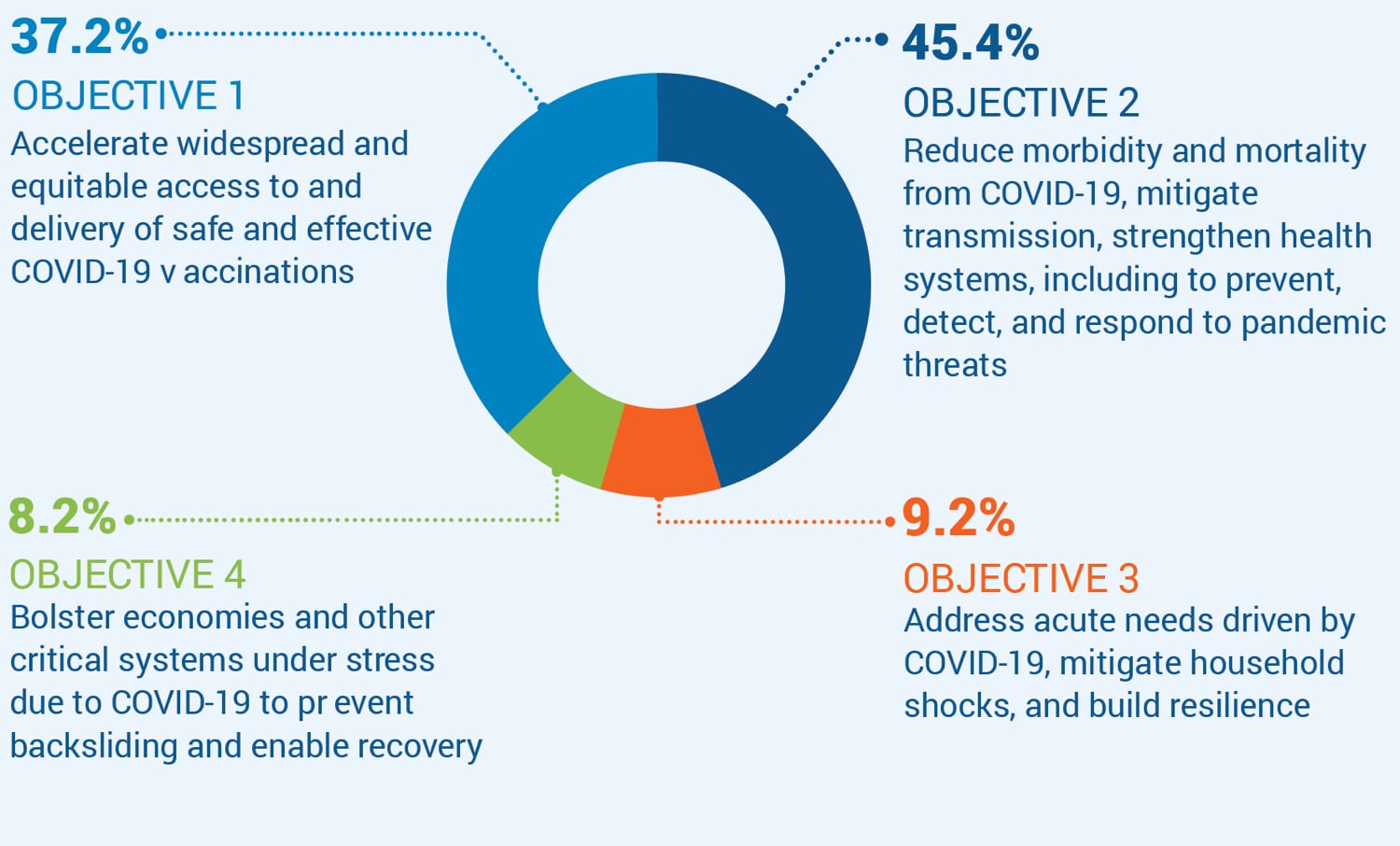
PAHO’s Implementation Approach
PAHO’s COVID‑19 response is grounded in the principles of engaging and empowering all of society and every arm of government through community-centered solutions, underpinned by the principles of equity and inclusiveness, with communities at the heart. The results summarized below demonstrate PAHO’s comparative advantages as an effective regional convener, coordinator, communicator, and implementer.
As with all our work, PAHO’s unique capacity to forge multi-country partnerships, tackle cross-border challenges, and to collect data directly from countries, along with the ability to link implementation expertise and knowledge-based technical work, forms the core of our success.
Activities and Results
The COVID‑19 vaccination campaign is the largest vaccination drive in history. While the Region’s rapid expansion of coverage during 2021 had markedly slowed by the beginning of 2022, PAHO has focused more time and resources in 2022 on reaching difficult to access and vulnerable populations, and better understanding barriers to vaccination to address heterogeneity in coverage rates within and between countries. Efforts have also been directed toward increasing uptake by improving cold chain management, extending the reach and relevance of communications campaigns, and addressing vaccine hesitancy, among other interventions.
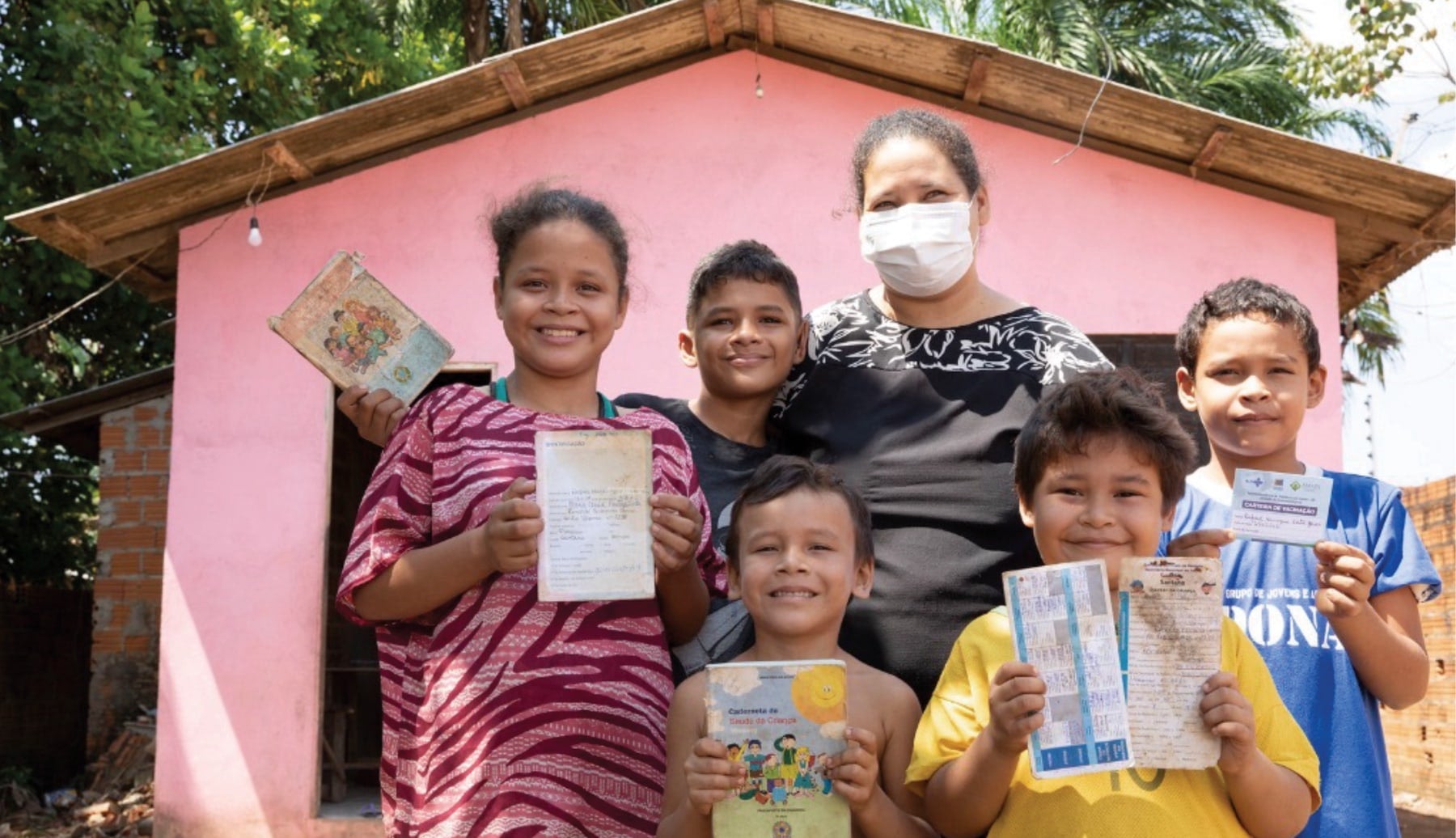
A family in a riverside community in Amapá, northern Brazil, display their vaccination certificates. Communities across the Region have been empowered through PAHO’s vaccination campaigns that prioritize community-centered approaches, inclusiveness and equity. ©PAHO
PAHO’s vaccination program activities cover all aspects of the process from distribution to uptake and administration. As a whole, this program continued to absorb the largest proportion of the COVID‑19 response funds. In line with the transition from initial rapid scale-up to addressing gaps and barriers, the majority of doses administered during 2022 were booster shots rather than initial doses for unvaccinated people. Therefore, the number of zero-dose persons in the Americas decreased slowly.
Moreover, with the US Government funds, PAHO was able to provide technical support to 33 countries/territories for vaccination operations, pro-vaccination communications campaigns, expansion of cold chain networks, supporting countries to increase manufacturing capacity, and provide internationally recognized vaccination certifications to cross-border travelers.
As of 31 December 2022, 2.09 billion COVID‑19 vaccine doses had been administered in the Americas, compared to 1.48 billion at the start of the year. By the end of 2022, 70.7% of the population had received at least two doses of vaccine, compared to 60% in January 2022. Six more countries (Panama, Colombia, Brazil, Costa Rica, Peru, Nicaragua) reached WHO’s global target of 70% vaccination coverage, bringing the total to 17 countries/territories in the Americas. During the same period, four countries/territories (Suriname, Dominica, The Bahamas, and Martinique) achieved the 40% vaccination coverage rate. Ten countries/territories, mostly in the Caribbean, had not reached the 40% threshold by the end of 2022.
COVID-19 Vaccine Coverage Rates by Country, 2020 to 2022
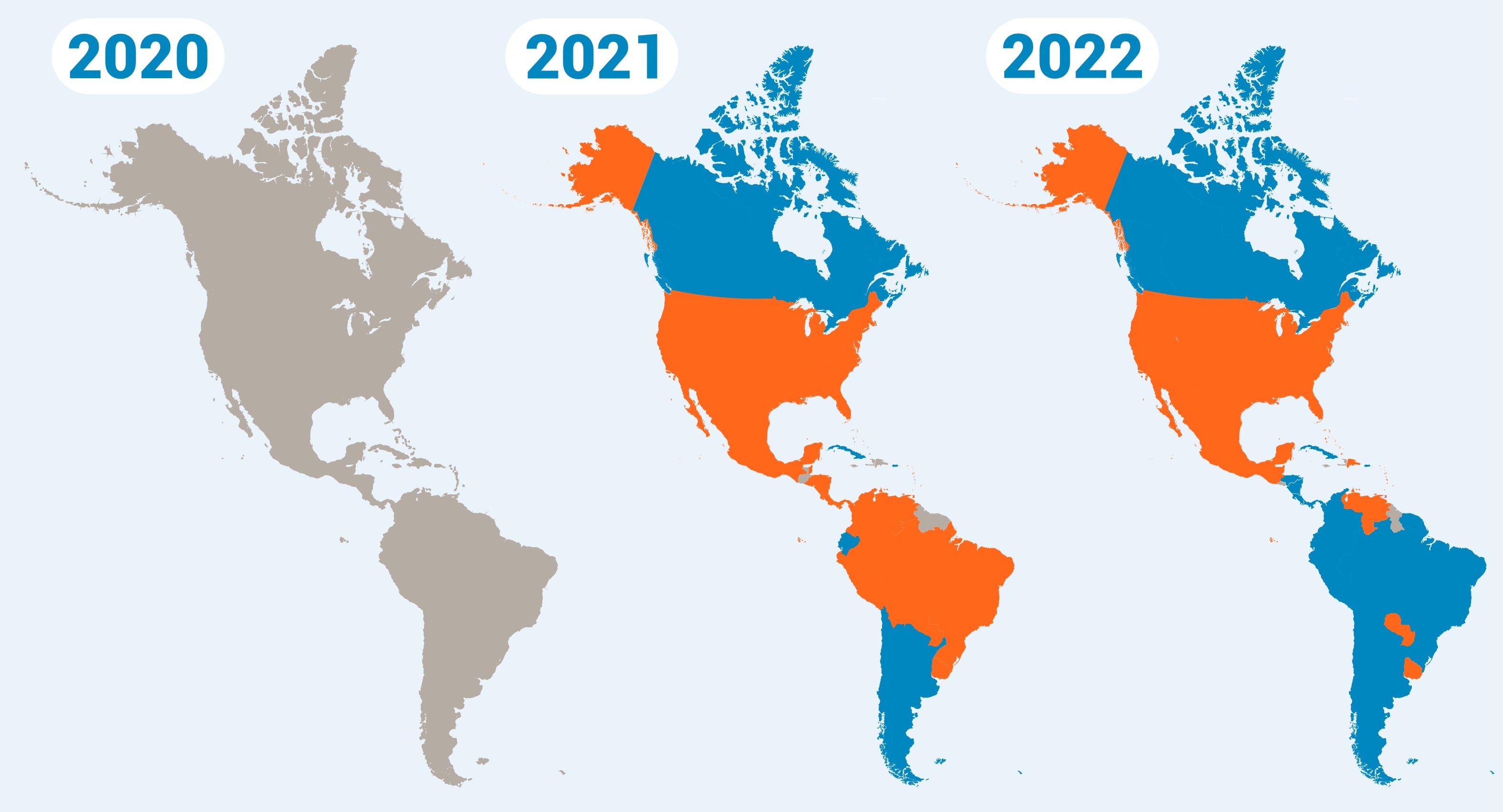
An important priority was to address the heterogeneity in vaccine rates within and between countries, whether a result of geographic isolation, conflict, poor access to health services, social exclusion, or vaccine hesitancy. PAHO’s activities supported countries to reach out to vulnerable populations through strategies such as deploying mobile vaccination brigades into rural areas, facilitating home visits, direct administration of vaccines, and producing communications products, including a series of nine booklets in question-and-answer format for health personnel, vaccination teams, journalists, and communicators. PAHO also undertook studies of specific barriers to vaccination in hard-to-reach groups. The results of this work are now being used in the planning of routine immunization catch-up efforts.
Numbers of individuals (millions) vaccinated against COVID-19 during 2022 in the Region of the Americas
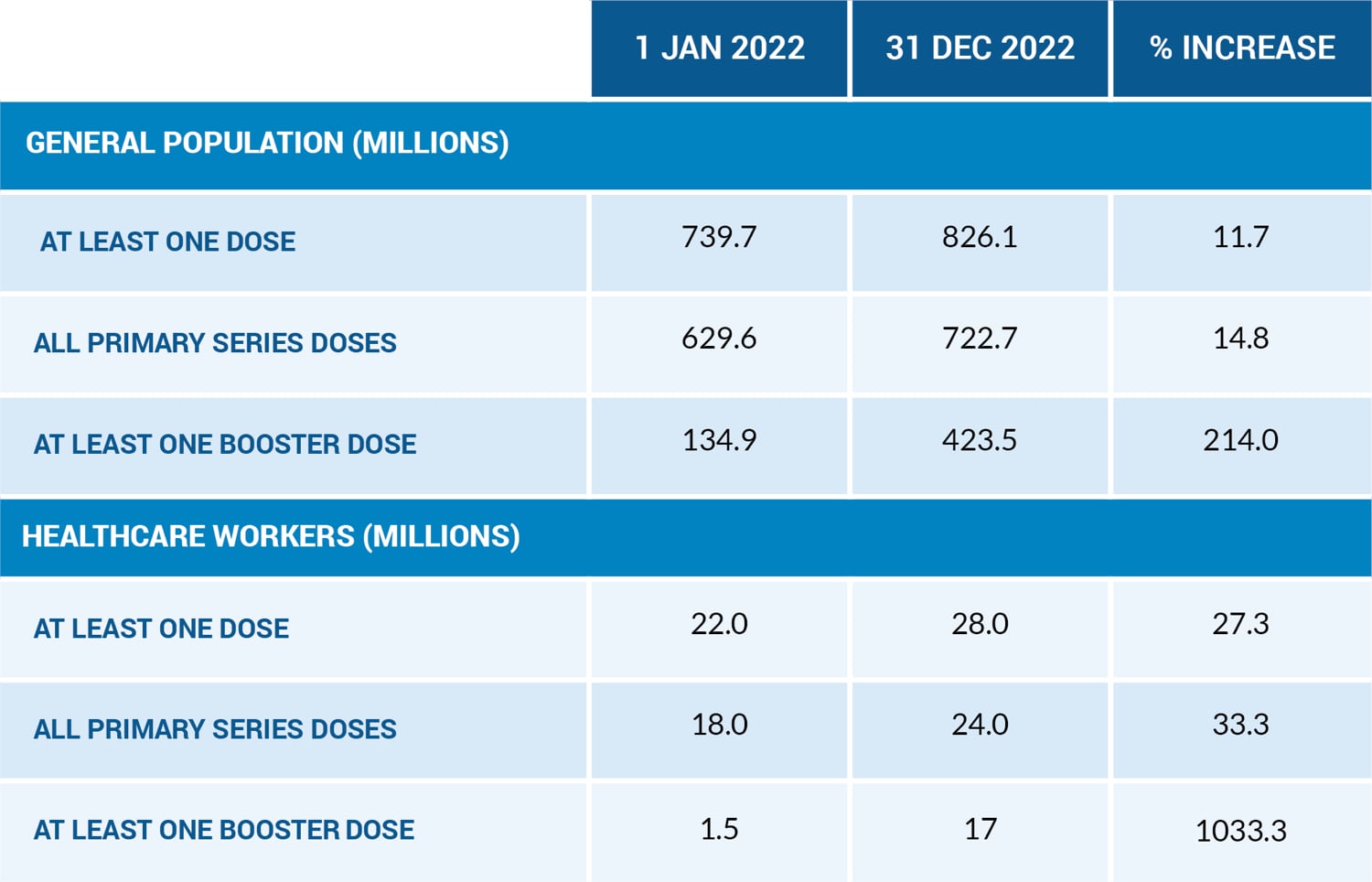
Given that new vaccine products usually take decades to reach market, and the COVID‑19 vaccine candidates were developed and approved in a matter of months, it was essential for the COVID‑19 vaccination drive to have a system of post-market surveillance for the enhanced detection, notification, and investigation of potential adverse events, known as Events Supposedly Attributable to Vaccination or Immunization (ESAVI). To this end, PAHO built a regional surveillance network, which was expanded to 18 countries during 2022. Data generated are used to inform rapid response activities to assess vaccine safety, minimize harm to persons who experience an adverse event, and strengthen immunization programs overall. The system has an important indirect benefit of countering vaccine hesitancy by assuring the safety of the vaccine roll out process.
Procurements
One of the most transformative interventions PAHO has been able to provide to countries is direct procurement, distribution, and delivery of critical supplies. The US Government contribution allowed countries to have timely access to COVID‑19 supplies, while releasing financial resources for urgent needs besides the pandemic.
Through its Revolving Fund, PAHO was able to support the acquisition of vaccines through the COVAX Facility to cover the Region’s needs in 2021. In 2022, procurements focused on ancillary vaccine supplies.
Procurements for The 2022 Response
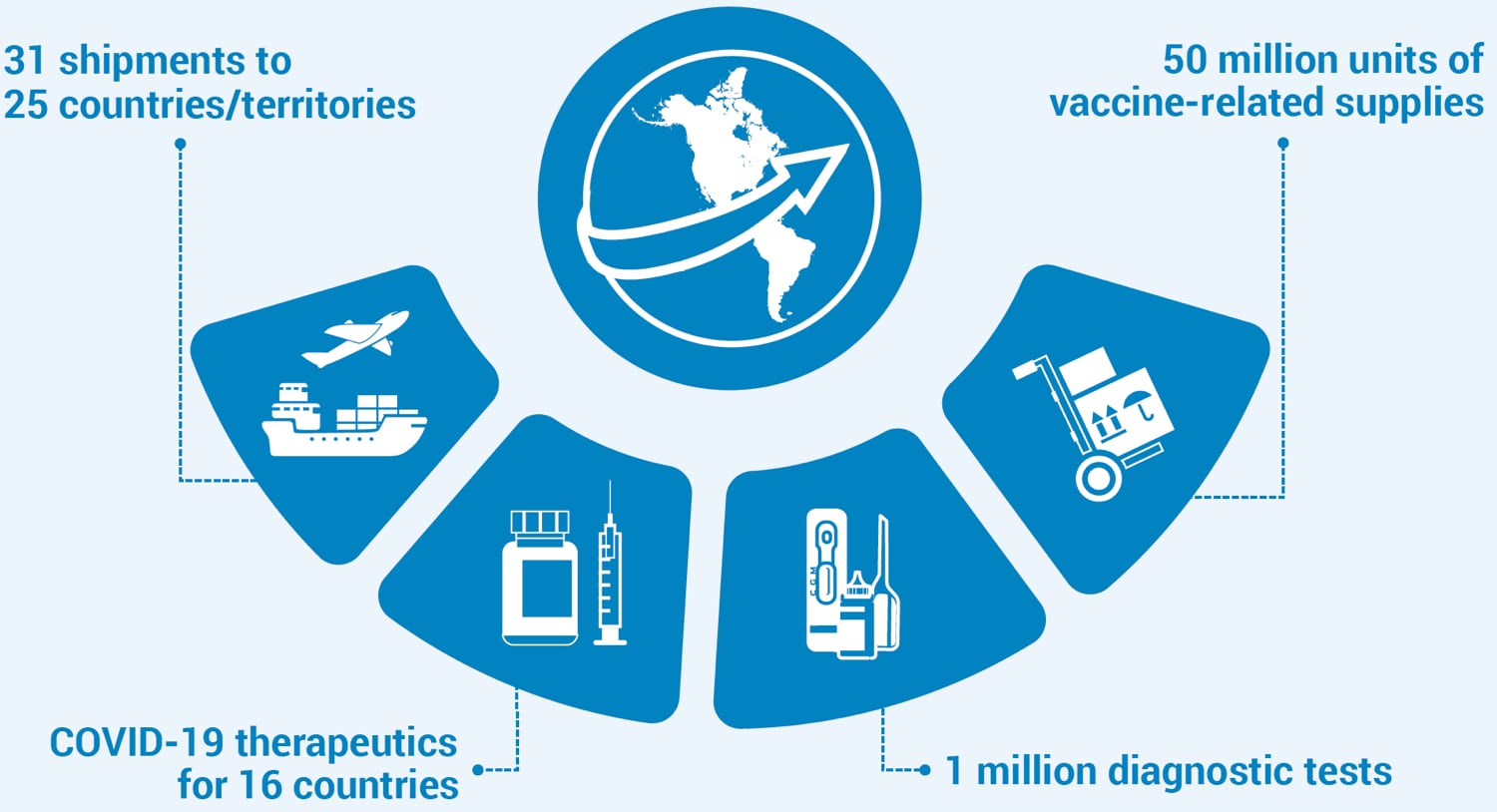
Using ARPA funds, PAHO procured more than 50 million units of supplies, including over 10 million syringes, 156 000 diluent (vials), and 220 000 safety boxes for storage of needles and syringes. PAHO completed 31 shipments to 25 countries/territories, with consignments that included 2.5 million gowns, 1.6 million gloves, 794 200 FFP2/KN95 respirators, and 366 000 face shields, 1077 oxygen concentrators with spare parts and renewable kits, 17 000 oximeters, and 6400 catheter kits. Other major budget lines for the COVID‑19 response included: medicines, including the monoclonal antibody tocilizumab for treatment of patients with severe COVID‑19, which was procured for 16 countries; and 1 082 500 antigen-detecting rapid diagnostic tests (Ag-RDT), which quickly test for infection with SARS-CoV-2.
Another 2 426 000 tests were made available at PAHO’s Panama warehouse along with 40 million syringes to be delivered to countries as needed. This stockpiling reduces shipping times and facilitates logistics so supplies arrive rapidly in countries facing emergencies.
Procurements were also key to PAHO’s assistance in 31 countries to strengthen cold chain capacity and their logistic and deployment capacities to carry out vaccination campaigns. Throughout the year, PAHO procured and distributed 858 refrigerators/freezers, 5 ultracold freezers, 5829 temperature-monitoring devices, 17 250 isothermal containers, and 6 refrigerator trucks. PAHO also financed installation of at least two cold rooms.
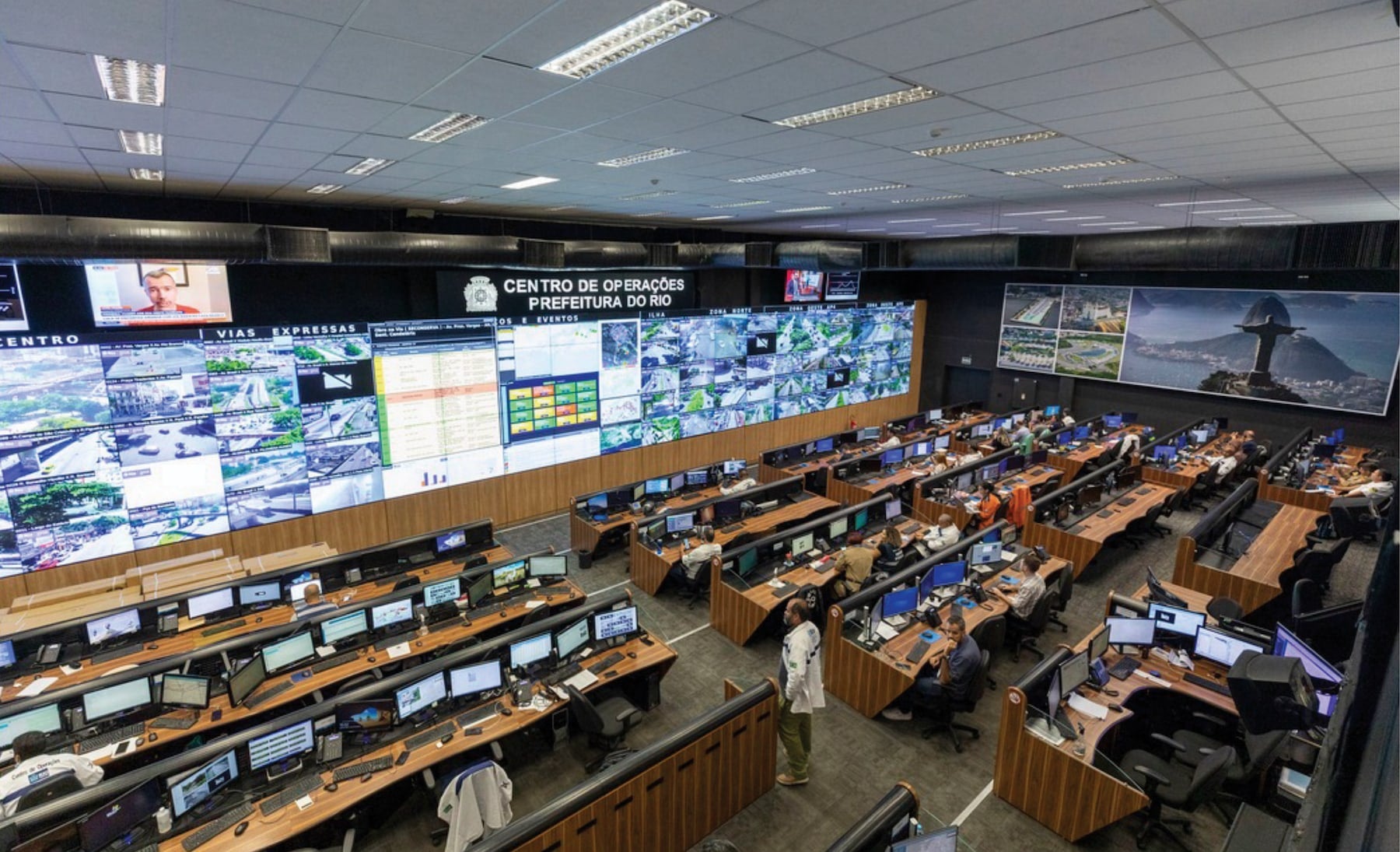
The Center for Epidemiological Intelligence in Brazil is coordinated by the Municipal Health Secretariat of Rio de Janeiro with technical cooperation from PAHO.
In addition to direct procurement, PAHO used its regional leadership role to advocate for a greater number of doses to be donated to the Region of the Americas. PAHO was involved in planning and operations related to bilateral donations and access to vaccines donated to COVAX by other countries. In addition, PAHO successfully advocated for regional dose-sharing, and supporting the reallocation of COVAX doses between participating countries.
Health System Strengthening
How effectively the front lines of the health system – PHC clinics and staff – have managed to adapt to provide clinical care for patients with COVID‑19 disease is a significant contributor to the decrease in mortality rates documented in 2022. Our activities build on, and enhance, countries’ own efforts to restore essential health services disrupted by the pandemic, while bolstering PHC services, laboratory and surveillance, technology and telemedicine, and social protection systems to incorporate an expanded vision of PHC-based service provision.
Emergency Surge Capacity and PHC
Our health system strengthening interventions focus on two main areas of health system response capability: increasing surge capacity and developing skills for management of patients with COVID‑19 and post-COVID conditions. For the former, PAHO provided technical and financial assistance to help countries establish and deploy national emergency medical teams, including those donated by US Southern Command (SOUTHCOM) US Department of Defense.
“The US Government contribution allowed countries to have timely access to COVID-19 supplies, while releasing financial resources for urgent needs besides the pandemic”
With PAHO support, which included procurements, training, and provision of kits to support simulation exercises in “all-terrain” conditions, 11 countries significantly strengthened their national emergency medical team capacity in 2022. This support has helped those countries progress toward the long-term goal of achieving global classification, which signifies that the emergency medical teams met requirements for registration at national and international levels and can assist in regional health emergencies beyond their own borders.
For the latter, PAHO used US Government funds to bolster the effectiveness of PHC in 16 countries, by providing training to improve health teams’ capacity to respond to crises, community health services management, information systems and telehealth, digital registration, and financing systems and in improved delivery of essential health services using a client-centered approach. PAHO’s initiatives incorporated the integrated health services delivery networks, a PAHO commitment to equitable, efficient, and high-quality health services.
The 2022 COVID-19 Response in Numbers
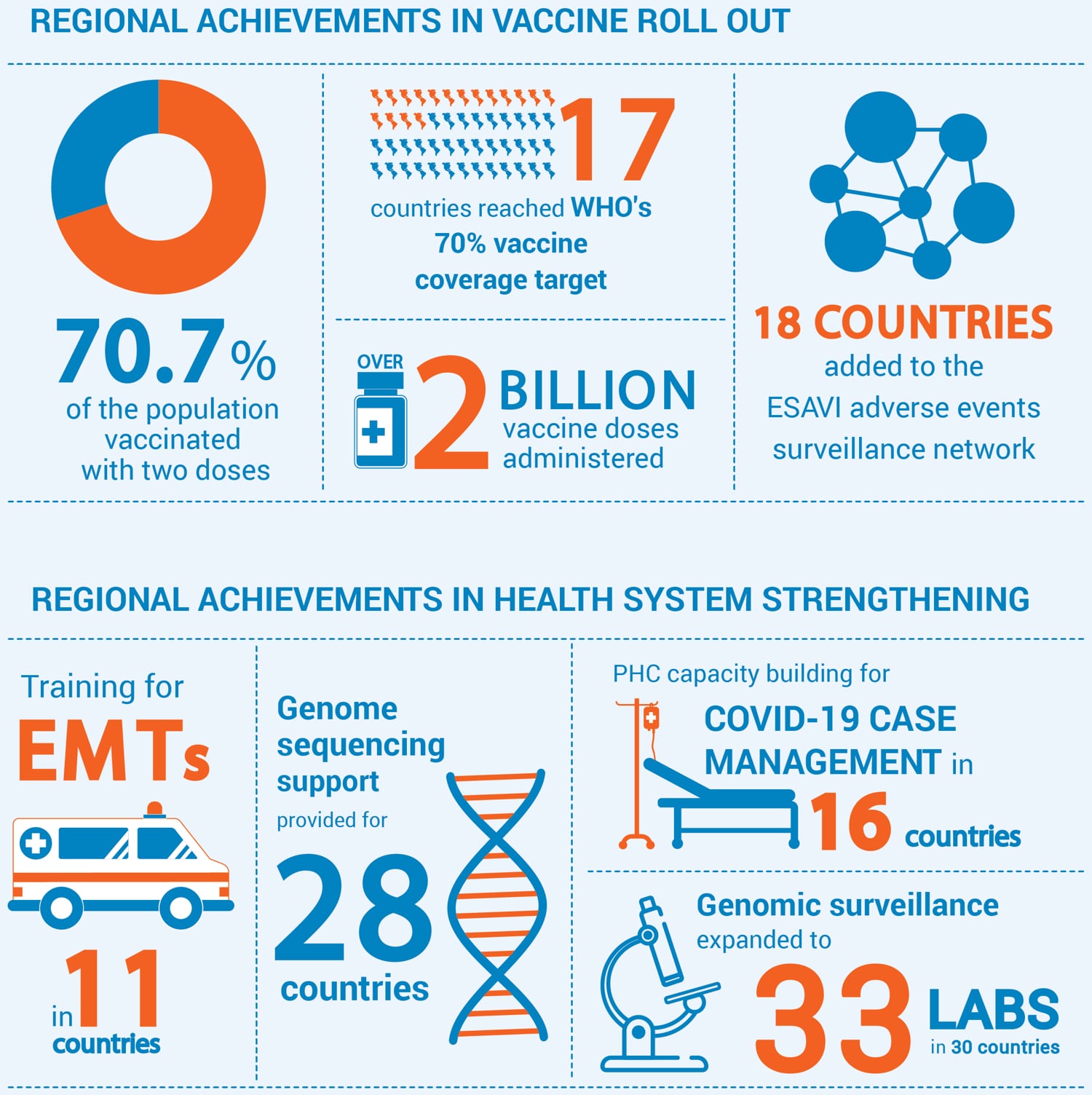
Infection Prevention and Control
With support from US Government funding, PAHO trained health workers in respiratory protection in public health facilities and organized webinars about COVID‑19 and infection prevention and control (IPC). Further, PAHO provided IPC training (basic and advanced) to 792 professionals in 19 countries/territories, and use of fit-test kits to test whether respirator masks fit correctly.
Expansion of Genome Sequencing Capacity
During 2022, PAHO provided technical and financial assistance that allowed Latin America and the Caribbean to increase its capacity for whole genome sequencing, which enables surveillance of SARS-CoV-2 and detection of variants of concern (VOCs) and variants of interest (VOIs). PAHO procured laboratory supplies and equipment and/or provided training for 28 countries. In addition, PAHO promoted participation in the COVID‑19 Genomic Surveillance Regional Network (COVIGEN), the PAHO-initiated network of genomic sequencing laboratories. By December 2022, COVIGEN had expanded to include 33 laboratories from 30 countries, reflecting an increase of six countries since January 2022.
Technical Analysis and Knowledge Products
The COVID‑19 pandemic laid bare the interdependence of information, communication, and public health. As cases soared, hunger for data, news, analysis, and – crucially – up-to-the-minute public health guidance grew exponentially, but misinformation has also become a real health threat. Importantly in this context, one of PAHO’s major strengths is its ability to link implementation expertise and knowledge-based technical work, which facilitates the continual review and assessment of priorities and activity-planning to ensure successful achievement of objectives.
PAHO responded to the COVID‑19-linked information demand by establishing a new emergency workflow for fast-tracking of COVID‑19-related publications and initiating a broad quality assurance project, aligned with WHO’s global initiative for quality improvement of global public goods, to tackle misinformation and assure credibility of published products. US Government funds supported PAHO to produce 175 COVID‑19-related publications during 2022, including systematic reviews, guidelines and clinical management advice, health systems analysis, and advice on all aspects of COVID‑19 response planning. PAHO’s technical experts also wrote or coauthored numerous studies published in scientific journals.
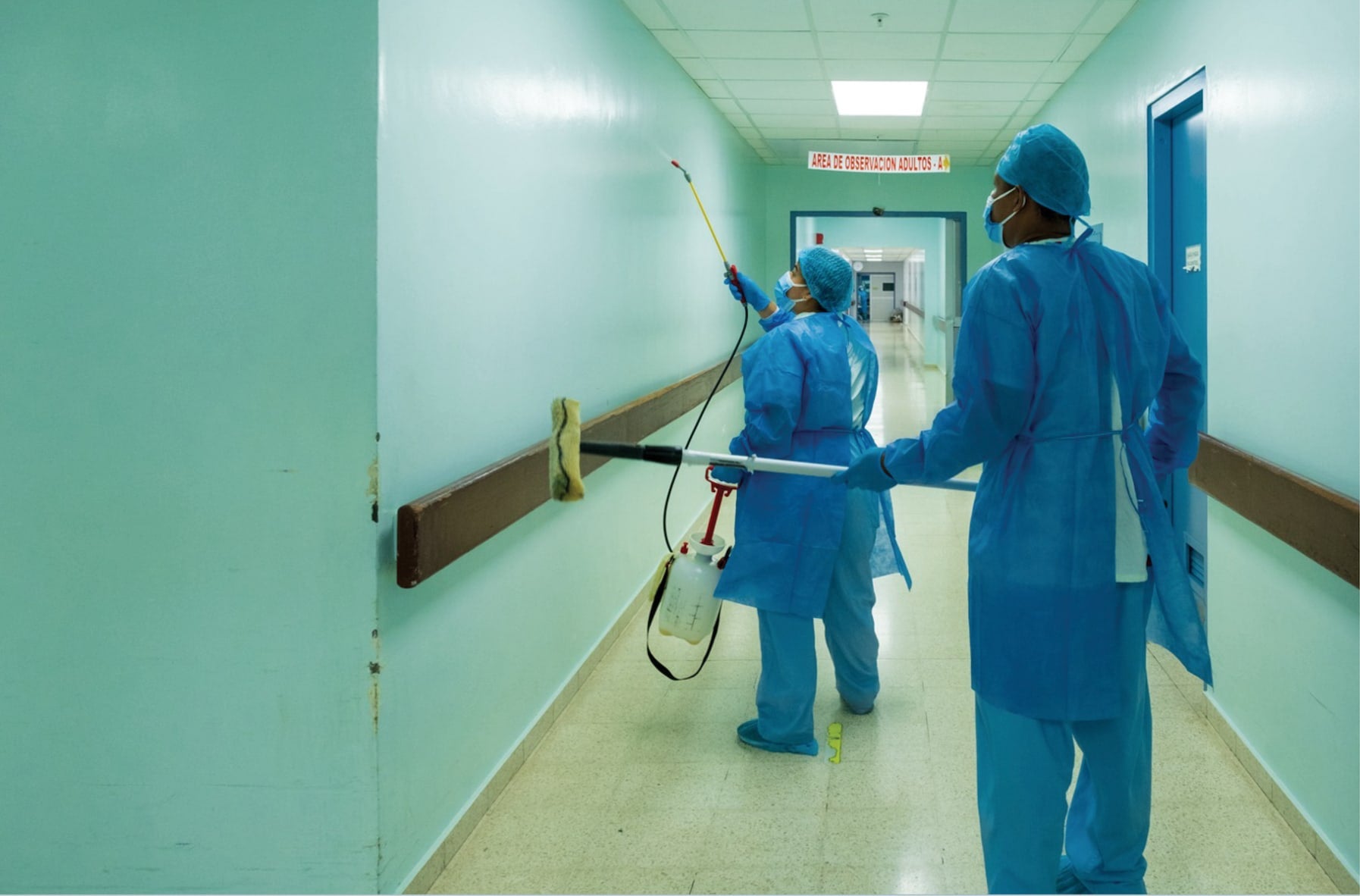
Evidence-based infection prevention and control measures for hospital wards that are used for patients who are severely ill with COVID-19 are among the topics of PAHO’s published guidance.
Highlights include:
- PAHO’s Ongoing Living Update of Potential COVID-19 Therapeutics Options reviews 240 potential therapeutics drawn from 745 randomized controlled trials and is an important global resource assessing the strength of evidence for new and existing treatment options.
- Living Systematic Review of Therapeutic Options for Post-COVID‑19 Condition. The document is based on 28 publications reporting on 25 therapeutic interventions.
- Guidelines for Prophylaxis and Management of Patients with Non-severe COVID‑19 in Latin America and the Caribbean (Second edition). The document includes recommendations for prophylaxis for people at risk of infection with SARS-CoV-2 and identification of markers and risk factors for mortality in patients with COVID‑19. (Available in PAHO’s four languages: English, Spanish, Portuguese, and French)
- PAHO Guidelines for Care of Critically Ill Adult Patients with COVID‑19 in the Americas (Third edition). The document includes recommendations for identifying mortality risk factors in critically ill patients, and for infection control, sample collection, supportive care, pharmacological treatment, early rehabilitation, diagnostic imaging use, prevention of complications, and discharge of requirements. (Available in PAHO’s four languages.)
“US Government funds supported PAHO to produce 175 COVID-19 related publications during 2022, including systematic reviews, guidelines and clinical management advice”
Documentation of Lessons Learned
In addition to published knowledge products, on a monthly basis PAHO updates the living BIGG-REC Database, which stores 3000 PAHO/WHO recommendations on COVID‑19 and other topics. With support from US Government funding, PAHO established a clinical intelligence network of more than 150 hospitals to promote collaboration and data mining and sharing on COVID‑19 and other health emergencies through use of artificial intelligence to standardize hospital-derived data. PAHO also provided technical support for the WHO global clinical platform for COVID‑19, a repository for anonymous patient data on COVID‑19 and post-COVID conditions that allows users to identify risk factors for severe cases and describe treatment interventions and outcomes, contributing to the scientific evidence on clinical management of the disease. More than 100 health facilities from 12 countries have contributed more than 100 000 cases from the Americas.
Further Reading: Knowledge Products
Available from: https://iris.paho.org/handle/10665.2/52719
Available from: https://iris.paho.org/handle/10665.2/57104
Available from: https://iris.paho.org/handle/10665.2/55068
Available from: https://iris.paho.org/handle/10665.2/53895
Website: https://bigg-rec.bvsalud.org/en
